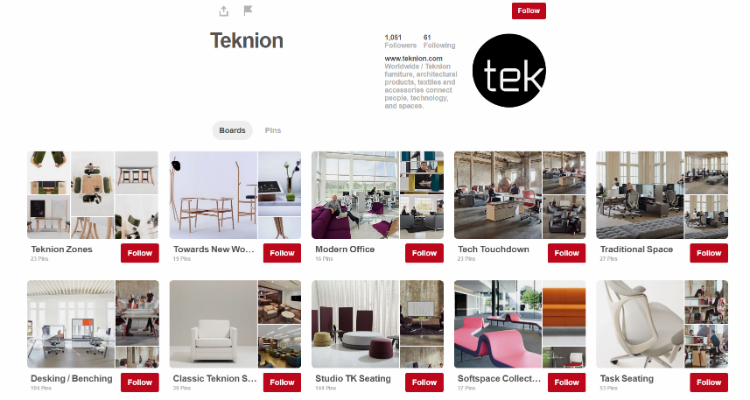How Teknion Connects People, Technology & Spaces with a WCM
Located in the United States, Canada, the United Kingdom, India, Russia, and Malaysia, Teknion is not your regular furniture designer, as its mission is building furniture that connects people, technology and spaces. As having been dedicated to innovative and sustainable design, the company’s website is one of the most critical aspects of their business. In recognition of needing to improve web content management and their website design, the organization picked Progress Sitefinity as their platform two years ago. Knowing our audience is eager to hear stories from end-users, during the SitefinitySummit 2017 event, Laura and I interviewed Claudio Ferreira, Senior Manager at Teknion, to inquire how they utilize their digital ecosystem to have a web presence that matches their unique brand identity.
Teknion has three public facing websites and they all run on Progress Sitefinity. During the interview, Claudio also announced that the fourth website will be established soon and that will also be running on Sitefinity. The company has been “poking around emerging technologies” to extend the reach of their showrooms. To put this goal into a perspective, they sell height adjustable desks, for instance, and they have created an app that helps the desk go up and down. Teknion is eager to go even beyond that. "Wouldn’t it be nice if the app did more than that,” said Claudio and explained: “If a user arrived at their workstation, for example, maybe the app could measure how long the users have been sitting or standing for or helping the user figure out what lighting settings should be appropriate.”
Given that Gartner forecasts the number of connected things will reach 20.8 billion by 2020, to me, focusing on connecting people, technology and spaces is such a great innovative idea. However, this kind of business model also requires a customized approach. Therefore, as he is heavily involved in the company’s marketing activities, we asked Claudio how they manage personalized marketing. “We don’t do automatic personalization with using our CMS platform just yet but we do set up various user journeys depending on their roles in the organization.” They do user journey set up not only for external but also for internal shareholders. In the scope of personalization, Teknion allows users to create their own dashboards/homepage with the items that they have used most often. This set up results in a win-win situation as the users are exposed to relevant content all the time while the marketers can customize their messaging in the memos and emails based on the items that the user chose. Claudio describes this model as “letting the users personalize it by themselves.”
Having moved from B2C marketing to B2B marketing, we were also hoping to hear Claudio’s opinions on the difference between these two areas when it comes to marketing activities. “It was a bit scary at first, to be honest because a lot of what I learned as a marketer growing up in B2C wouldn’t apply or apply in a funny way or, simply, our industry hadn’t even woken up to some of those ideas. For instance, when I first started, I spent a long time even on proving that social media was a channel that we should adopt.” Then, he realized that there are pros and cons, and some of the cons also can be seen as pros. To that end, he pointed out that there is not a real benchmark for the B2B market in some cases. Even though it seems like a con, Claudio believes that therein lies an opportunity to draw your own path.
Another important talking point discussed during the interview was how they have started utilizing social media as an extension of their sales efforts, besides utilizing it as one of their marketing efforts. In that regard, Claudio gave Pinterest as an example and said that they tap into Pinterest as a sales tool instead of a marketing tool. They started off with a tiny presence on the platform, and then, they developed it with working with some interior architects and designers in order to build a board. Now, in the resources section of their websites, visitors can visit a Pinterest board or a page that is organized by warm reds and cool blues. He also added that from the marketing perspective, even though this method is hurting the bounce rate of the websites, from the sales standpoint, it still brings other greater advantages to the company.

When it comes to having a discussion on how a web content management system is utilized, without inquiring how well the vendor delivers integration, which is one of the most important capabilities, the conversation would have been incomplete. Teknion has done many integrations with Sitefinity, including Bynder Digital Asset Management Platform, Salesforce CRM, Elastic Search, and Maxmind. Claudio noted that Bynder was the biggest integration they have done so far. Teknion is a very content heavy company as they run 40 gigabytes of DAM alone every day and their public-facing websites include over 32,000 files. With the smooth integration, now 250 people are able to contribute content into the DAM by just checking off a list of criteria.
Having a small team of half a dozen people within the corporate marketing team, Teknion also consistently needs efficiency and productivity. The organization agrees that with Progress Sitefinity, they have been able to do more with less. However, they say that the company is always looking for new ways to both improve the customer experience and the efficiency of employees.
My POV
Teknion is another example of the fact that Web Content Management Systems (WCMs) have gone beyond just a platform for getting content out. Every day, a new business use case for WCM pops up. As digital businesses emerge beyond the web, WCM platforms continue to be the gravitational center of digital experiences. In the rise of the demand for relevant, meaningful content, brands have to identify and serve personalized experiences on demand, in order to respond to each unique customer situation. Teknion, for instance, is not only selling office furniture, but trying to change the way people experience work in the digital era. Another thing that I really liked about Teknion is the fact that the brand has already jumped on the IoT bandwagon, as this particular area requires a sheer amount of new technologies and skills that so many organizations have yet to master. Knowing Gartner estimates tens of billions of everyday devices will be equipped with sensors to process and analyze data by 2020, no doubt that these efforts will provide Teknion with an upper hand in the competition with its rivals as so many non-tech companies are still struggling with finding their place in the IoT-enabled landscape.

Venus Tamturk
Venus is the Media Reporter for CMS-Connected, with one of her tasks to write thorough articles by creating the most up-to-date and engaging content using B2B digital marketing. She enjoys increasing brand equity and conversion through the strategic use of social media channels and integrated media marketing plans.

Laura Myers
A digital business, marketing and social media enthusiast, Laura thrives on asking unique, insightful questions to ignite conversation. At an event or remotely, she enjoys any opportunity to connect with like-minded people in the industry.